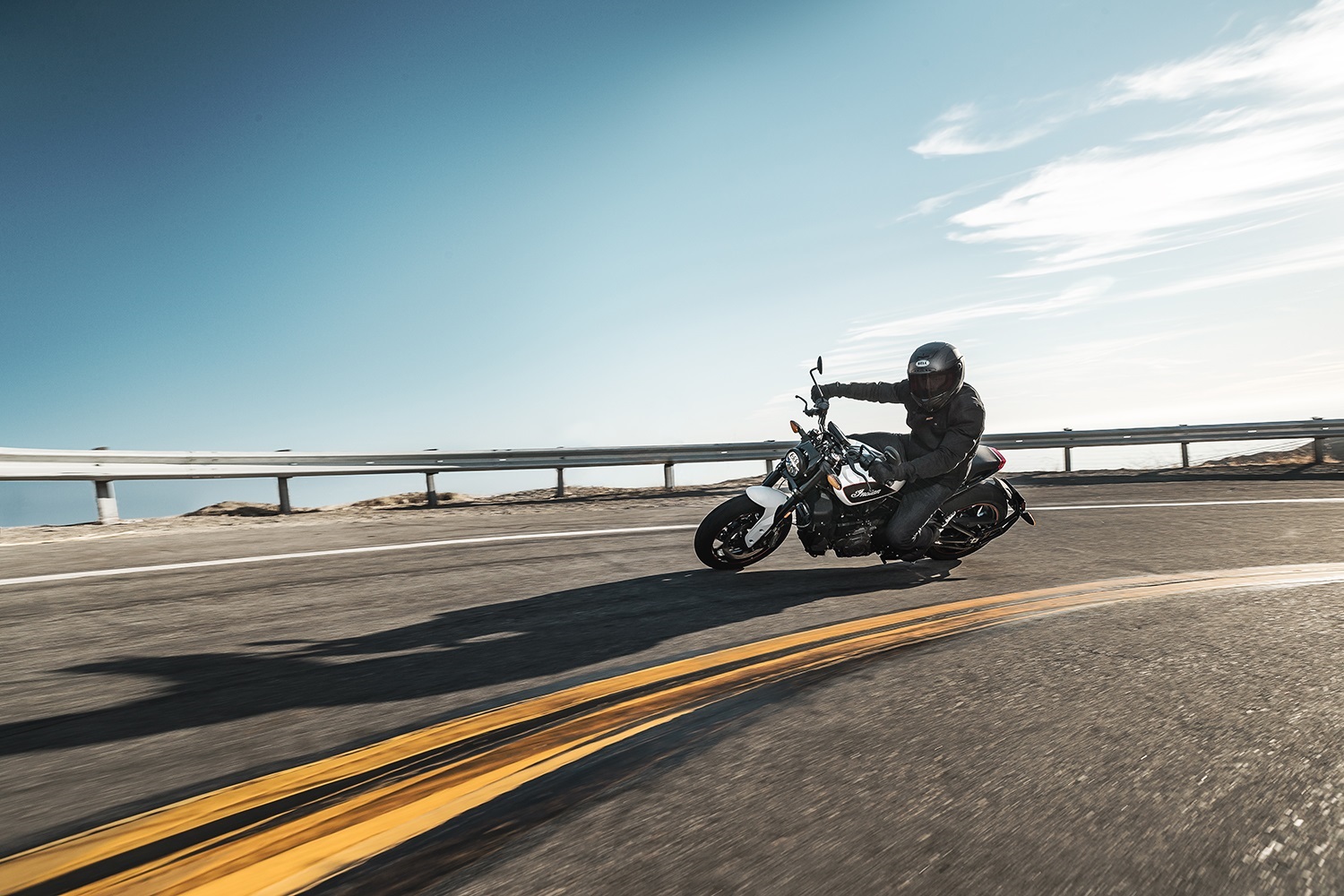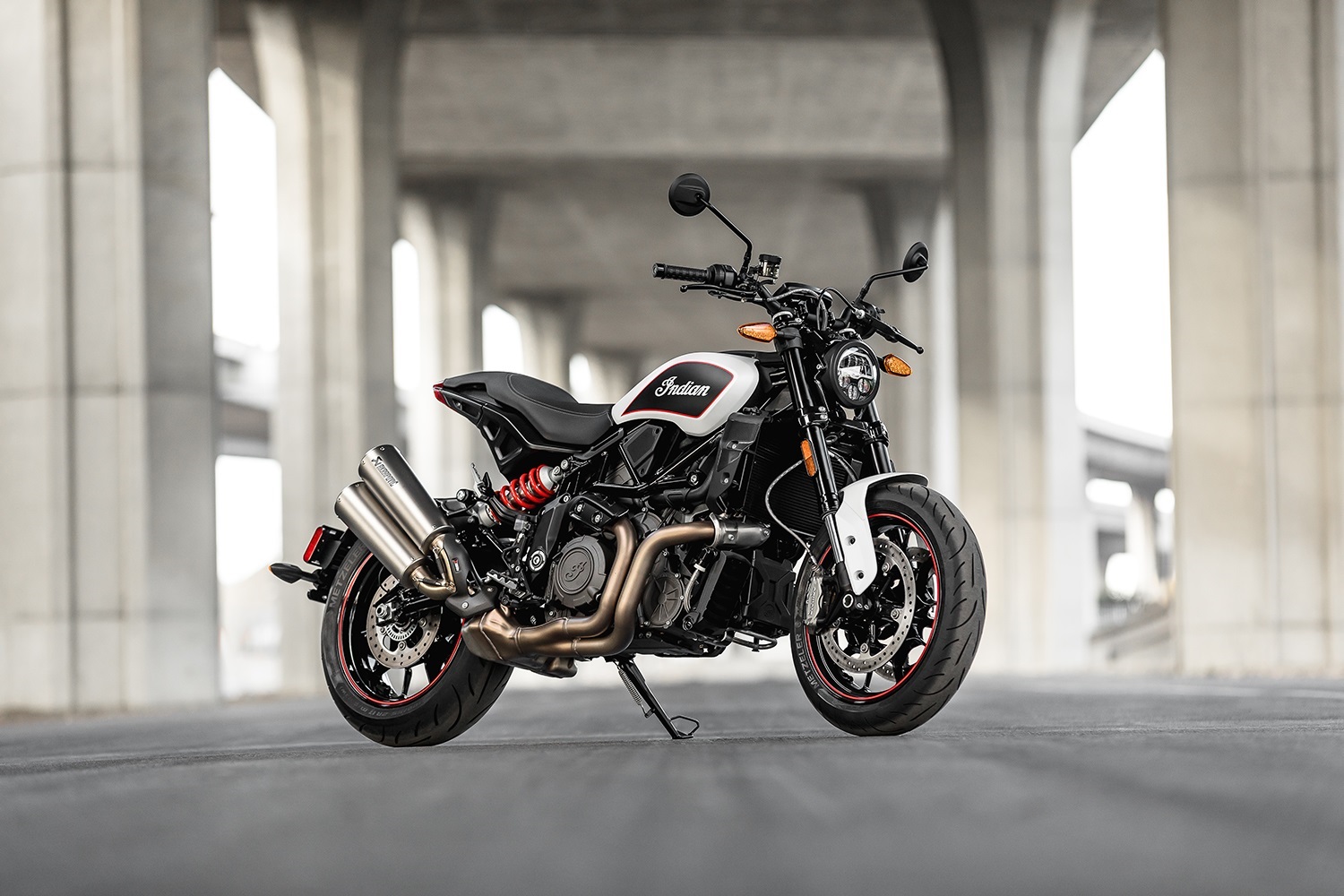Today over at RevZilla, my colleague Zack Courts reports on riding the new 2022 Indian FTR S. He’s actually pretty positive about the motorcycle, feeling it is closer than ever to being the naked performance bike many riders have long hoped a U.S. manufacturer would build. You should definitely read his review — but since I haven’t yet ridden the bike, my focus is slightly different.
I’m wondering where the flat track in FTR went. And why. And I have a theory.

The changes to the 2022 Indian FTR, especially the 17-inch wheels, should make it perform even better on the street, at the expense of losing some flat-track style. It should turn better, both right as well as left. Indian photo.
But first, here’s the background. When Indian announced the revision of the FTR in January, I noted in my report at RevZilla that three of the versions, the base FTR, the FTR S and the FTR Carbon, would now be rolling on 17-inch wheels, the standard size for street and highway use these days. Having 17-inch tires in the standard 120 front and 180 rear widths gives riders a vast choice of tires, from long-lasting but still high performing sport-touring tires to the stickiest DOT-legal race tires. Indian will continue making the FTR Rally, with the original 19-inch front wheel and 18-inch rear wheel, sticking closer to the flat-track style and street-tracker image that originally inspired the FTR. But to me it was clear that the focus had shifted from an emphasis on flat-track style to an emphasis on making the FTR a better performing street bike.
One other thing nailed home that thought. In the lengthy news release Indian issued explaining the redesign for the 2022 models, it never mentioned flat-track racing, never mentioned the company’s all-conquering FTR750 race bike or dominant factory racing team. It’s as if the original inspiration behind the model, building a stylish and well performing street tracker, had disappeared altogether.
And I wondered why.
I have theories, of course.

The restyle of the 2022 Indian FTR edges it further away from its street-tracker roots. Indian photo.
Flat-track racing, always about to be the next big thing
Just as the old saying goes that nuclear fusion as a commercially viable source of energy has always been 30 years away, I feel like for quite some time some people have been saying that flat-track racing is a couple of years away from being the next big thing. A few years ago, I noticed an odd flurry of articles in non-motorcycle media about how the American Flat Track series was about to be the next big success. Now, as someone who’s been involved in the public relations and news media dance in a variety of roles, when I see a series of articles in different publications that all postulate the same thing, I recognize the possibility that they could all be spotting an emerging trend. I also recognize the far greater possibility that there could be a particularly adept public relations person at work spreading that theme.
Frankly, that’s not hard to do when it comes to selling motorcycle topics to general media. Those outlets’ knowledge of the industry and sport are shallow, given that motorcycling is such a niche pursuit in the United States. So I didn’t buy the argument that flat-track racing is about to reach new levels of popularity. So far, I haven’t been proven wrong.
And this is where the Indian FTR becomes my next piece of evidence.
You know the old saying, “Win on Sunday, sell on Monday.” Even though both Mark Gardiner and I have argued that the real truth is “Sell on Tuesday through Saturday so you can afford to go racing on Sunday,” the fact remains that racing success does burnish the brand and can help sell motorcycles. And nobody has had more unadulterated racing success in recent years than Indian in American Flat Track. Since the company introduced its FTR750, it has swept numerous podiums, won all the championships and humiliated rival Harley-Davidson.
Yet Indian didn’t even bother to mention that huge success once when introducing its new FTR.
That reinforces a few opinions I’d previously formed, namely:
- Flat-track racing, an antique-looking sport based on turning left on old county fairgrounds horse-racing tracks, has the same problem Harley-Davidson does: Old fans are aging out faster than young, new ones are coming in. If touting its flat-track success would sell more FTRs to the kind of younger buyers likely to consider them, Indian would surely be doing it. But since they totally abandoned marketing the FTR as a street tracker or emphasizing its flat-track roots, that must not be the case.
- Flat-track racing is not the next big thing. It was the big thing 50 years ago. We don’t go back to the past, though we may reinvent it in new forms. The next big thing is always something new, not something old.
- Flat-track style still has its fans in some corners of the Instagram world and among some custom builders, but for a production bike like the FTR, being a better street motorcycle is more important than adhering to some theoretical purity as a street tracker. That’s the course Indian has taken. Now let’s see if it succeeds.
And let’s hope it does, because the U.S. motorcycle manufacturers desperately need a win or two from a motorcycle that’s not the same old recycled heavyweight cruisers, baggers and tourers. Building something outside that comfort zone is the only way we’ll still have large, successful U.S. motorcycle manufacturers for decades to come. In that sense, the FTR is a pioneer and a test case, and we should all hope it succeeds.
